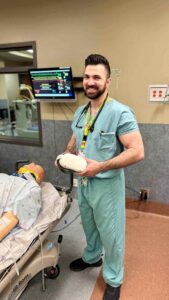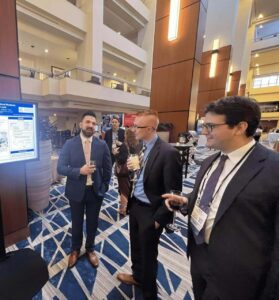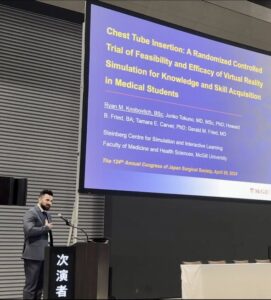Exploring New Frontiers in Clinical Training with Virtual Reality
Simulation in medical education has become a cornerstone of clinical training but it requires significant resources. Many health care systems struggle with growing demands and finite budgets, which means limited learning opportunities.
What is VR in Clinical Training?
Virtual Reality (VR) is an immersive technology that has gained traction as an educational tool in various clinical areas, such as surgery and emergency medicine. Users wear a head-mounted display that immerses them in an ultra-realistic virtual environment and use special controllers to explore and interact with their surroundings as they would in real life. VR’s practical advantage is its independent and on-demand use, making it a versatile tool for enhancing clinical training.
 We interviewed our Chief Medical Educator, Ryan Knobovitch, to discuss his experience with simulation-based education and research in VR.
We interviewed our Chief Medical Educator, Ryan Knobovitch, to discuss his experience with simulation-based education and research in VR.
How did you get involved in simulation and VR research?
During my first year of medical school, I was introduced to simulation training for medical interviewing and point-of-care ultrasound. This experience was crucial in developing my essential clinical skills and preparing me for future patient interactions. It inspired me to contact Dr. Gerald Fried, an international pioneer in minimally invasive surgery and the esteemed Director of the Steinberg Centre for Simulation and Interactive Learning, to discuss my research interests in simulation-based education for learning procedural skills. Our conversation centered around technological innovation in medical education and simulation, during which he introduced me to VR.
While medical institutions worldwide have recognized VR’s potential in the clinical realm, the evidence of its effectiveness in teaching surgical procedures to medical students is limited. In collaboration with other researchers at McGill University, specifically Dr. Junko Tokuno, a thoracic surgeon from Kyoto, Japan, we designed a pilot study that investigated the effects of VR training as part of a blended learning approach for teaching chest tube insertion to medical students.

Ryan Knobovitch (left) discusses VR’s potential in clinical training with surgical residents during the 2024 Annual Meeting of the Association for Surgical Education in Orlando, Florida.
What did your research study reveal about VR in medical training?
We recruited first and second-year medical students, most of whom had no clinical training or VR experience. Our findings showed that students who received VR training demonstrated significantly greater technical skills and higher procedural confidence during a live simulation than those who did not. Our team believes that integrating VR into current educational practices may lead to more effective and efficient use of costly live simulation training. Therefore, future studies should investigate whether periodic VR exposure can enhance the durability and longevity of live simulation.
Have you shared your findings with any relevant journals?
I have been diligently working on a manuscript that I hope will be accepted for peer review and subsequent publication.
In April 2024, I had the privilege of presenting the results of our study in a podium presentation at the 124th Annual Congress of the Japan Surgical Society in Nagoya, Japan. It was a humbling experience to be invited to the oldest and most prestigious society of surgery in Japan for my first academic conference as a podium speaker, no less. A few days later, I had the opportunity to share the results of a sub-study we conducted on VR’s usability and cognitive load at the 2024 Annual Meeting of the Association for Surgical Education in Orlando, Florida. Presenting at these conferences was an honor and undoubtedly the highlight of my medical school journey thus far.
I am eternally grateful to my co-investigators and proud to have collaborated on such a meaningful study with an incredible team. I am also thankful to McGill University for receiving the John Henry Collis Undergraduate Award for Medical Research for my work on this study.
Do you think VR will become part of formal medical education?
It’s difficult to say at this stage, but our study has helped to demonstrate the potential learning

Ryan Knobovitch presented his VR research at the 124th Annual Congress of the Japan Surgical Society in Nagoya, Japan, in April 2024.
opportunities that VR can provide. VR is not a “silver bullet,” as I often say. Still, it gives learners a reliable tool to apply their knowledge in a practical way that emphasizes autonomous, blended, and competency-based learning. This aligns with what many medical programs expect of today’s learners.
The pace of change in medicine is relentless and exponential. The medical challenges of an aging population, a wide range of treatment options, the interprofessional nature of care, and the complexities of healthcare systems have all evolved significantly over the past 20 years. What works today might be obsolete in a year from now. How we train future clinicians needs to reflect these dynamic changes.
Evidence supporting the implementation and integration of VR into medical school curricula will continue to grow, and eventually, VR technology will become mainstream in clinical training.
The Future of Life-Saving Training Opportunities with VR technology
VR-based clinical training can benefit anyone in health care, offering a potentially cost-effective way to independently practice and develop clinical skills. This can apply to experienced practitioners who may need a quick refresher on a procedure they haven’t performed recently or trainees who don’t have regular access to expensive simulation equipment.
The innovative application of VR training within the Disque Foundation presents an exciting opportunity. Our SALI trainers could not only practice life-saving skills taught in our BLS, ACLS, and PALS courses, but also explore new techniques and approaches for providing high-quality care. VR is a future tool to teach local providers simple life-saving procedures that they would otherwise never have the resources to learn. This aligns perfectly with our mission of advancing health care education to the underserved through advanced technology. The potential of VR in medical training is limitless and we’re incredibly excited to have Ryan who is interested in simulation-based education and VR, and shows us the future.
